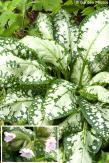Pulmonaria officinalis 'Ocupol' OPAL

Pulmonaria officinalis 'Ocupol' OPAL
lungwort
lungwort
| SIZE/TYPE | low or groundcovering |
|---|---|
| low perennial | |
| USUAL HEIGHT | 0.2-0.3m |
| USUAL WIDTH | 0.3-0.5m |
| LEAVES | semi-deciduous broadleaf |
| COLOUR OF LEAVES |
  varigated:green and silver varigated:green and silver |
| FLOWERS | showy |
| COLOUR OF FLOWERS |
 + + + + multicolored:white and pink and violet multicolored:white and pink and violet
|
| BLOOMING TIME | April - May |
| LOCATION | semi-shade to shade |
| SOIL TYPE | any (acidic to alkaline) |
| SOIL MOISTURE REQUIREMENTS | evenly moist but well-drained |
| USDA zone (lowest) | 5 (down to -29°C) |
| WINTER PROTECTION | |
| FOR ZONE 5+6 |

|
| FOR ZONE 7 |

|
| BELONGS TO CATEGORIES | Perennials |
Lungwort is a genus of about 16 perennial species originally found in woodlands and at streamsides in Europe and Asia, and for centuries has been used as a medicinal plant. Plants are characterized by pink and blue flowers, and many of them make large, very attractive, almost exotic looking leaves.
OPAL is an attractive lungwort variety with variegated foliage and delicate, very light pink and mauve to almost white flowers. It was discovered in 1986 by Elisabeth Susan Cupitt of Blooms of Bressingham as a chance seedling among many plants of the species. In C.E. climate flowering begins during the first warm days of spring, usually in the first half of April, and continues for about a month. The stem are rather short, only around 20-25 cm tall, and appear against a background of broadly lanceolate, silver-spotted, mid-green leaves that increase their size two or three times during summer and flip the portion of silver and green in favour of silvery grey. You can enhance their quality by hard pruning immediately after flowering by cutting the whole plant down to the ground. New leaves will be larger, healthier, and will remain handsome and evergreen during mild winters. OPAL was granted a US Patent No. PP12931 in 2002.
Lungwort, especially its large-leaved forms need equally moist, fertile soil that does not dry out, or is waterlogged. It needs partial or complete shade; it is an ideal understory of tall trees providing only filtered sunlight. Use it in mixed beds with hostas or liriope. Even if the leaves look alright after winter remove all of them in early spring. Hardy to min. -29°C (USDA zone 5).
Last update 02-10-2023
OPAL is an attractive lungwort variety with variegated foliage and delicate, very light pink and mauve to almost white flowers. It was discovered in 1986 by Elisabeth Susan Cupitt of Blooms of Bressingham as a chance seedling among many plants of the species. In C.E. climate flowering begins during the first warm days of spring, usually in the first half of April, and continues for about a month. The stem are rather short, only around 20-25 cm tall, and appear against a background of broadly lanceolate, silver-spotted, mid-green leaves that increase their size two or three times during summer and flip the portion of silver and green in favour of silvery grey. You can enhance their quality by hard pruning immediately after flowering by cutting the whole plant down to the ground. New leaves will be larger, healthier, and will remain handsome and evergreen during mild winters. OPAL was granted a US Patent No. PP12931 in 2002.
Lungwort, especially its large-leaved forms need equally moist, fertile soil that does not dry out, or is waterlogged. It needs partial or complete shade; it is an ideal understory of tall trees providing only filtered sunlight. Use it in mixed beds with hostas or liriope. Even if the leaves look alright after winter remove all of them in early spring. Hardy to min. -29°C (USDA zone 5).
Last update 02-10-2023
SIZES and PRICES
CURRENTLY SOLD OUT
GLOSSARY
|










